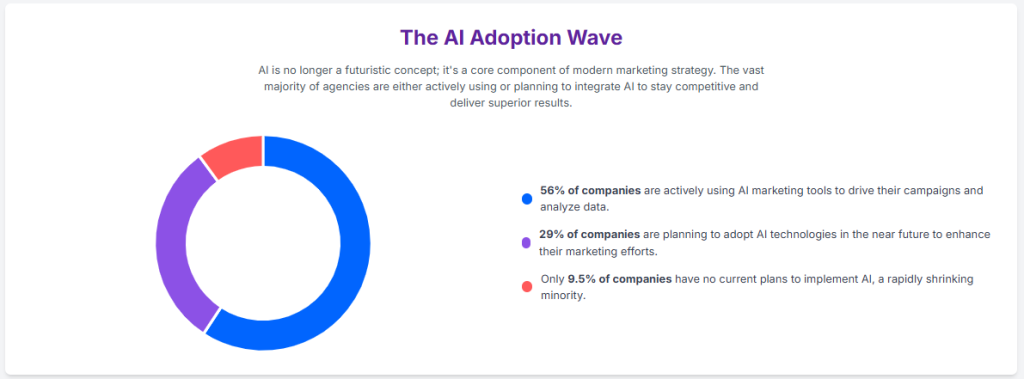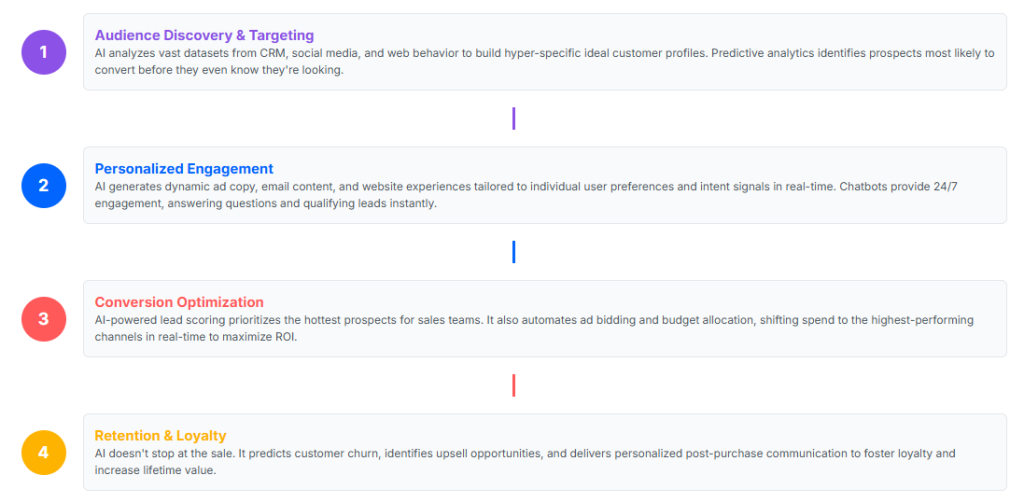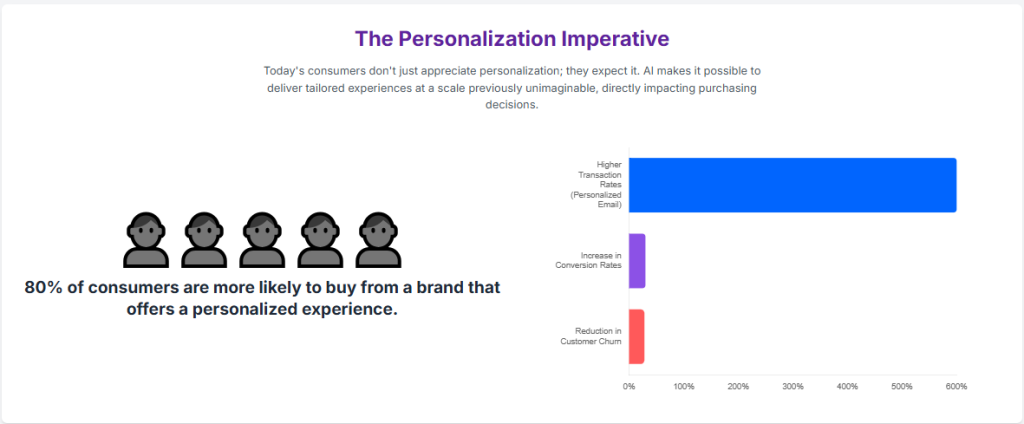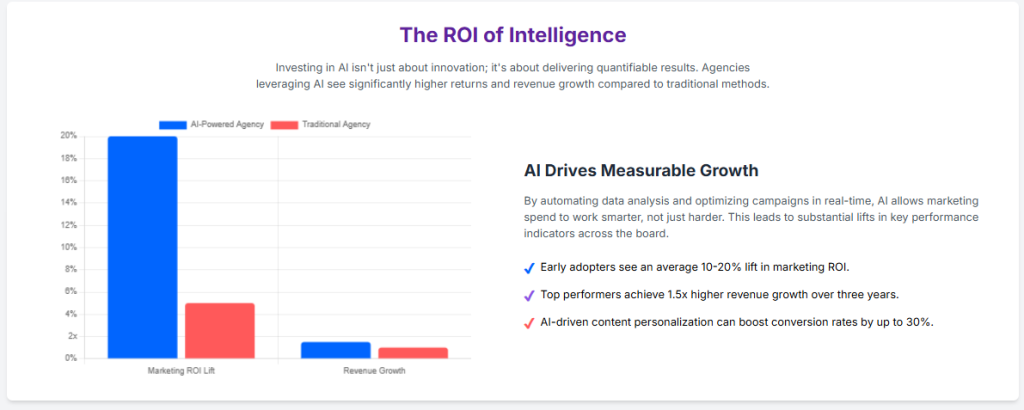Artificial Intelligence (AI) is no longer a futuristic concept in marketing—it’s the new reality. For modern marketing agencies, the conversation has shifted from if they should use AI to how they can leverage it for the ultimate competitive advantage. While many have adopted generative tools for content creation, a more profound transformation is underway: the rise of Agentic AI. These autonomous systems are not just tools; they are intelligent, goal-driven digital team members capable of planning, executing, and optimizing entire customer acquisition campaigns.
This article dives deep into the world of AI agents, moving beyond the hype to provide a strategic roadmap for your agency. We’ll explore how these intelligent systems are reshaping the marketing funnel, quantify their staggering impact on ROI, and provide a playbook for successful implementation. Prepare to discover how to harness the agentic edge and redefine what’s possible in customer acquisition.
The New Marketing Intelligence: Understanding AI Agents
The leap from simple automation to intelligent agents marks a fundamental paradigm shift. To truly leverage this technology, we must first understand what makes these agents different and the strategic roles they play in a modern marketing ecosystem.

From Automation to Autonomy: A New Class of Marketing Operative
An AI agent is more than just a script that follows pre-programmed rules. It’s an intelligent software program that can perceive its digital environment, make rational decisions, and take autonomous actions to achieve a specific goal. Think of it as the difference between a tool and a team member. Traditional automation follows “if-this-then-that” logic; an AI agent is given a high-level objective, like “reduce customer acquisition cost,” and can devise its own steps to achieve it.
The key characteristics that set AI agents apart are:
- Goal-Oriented Behavior: They are driven by objectives, not just tasks. Their actions are designed to maximize success based on performance metrics.
- Continuous Learning: They adapt and improve over time by analyzing performance data and feedback, refining their strategies without human intervention.
- Perception and Rationality: They collect and process data from multiple sources (like analytics platforms and CRMs via APIs) to make informed decisions.
- Adaptability and Proactivity: They can adjust to changing market conditions and even use predictive models to anticipate future trends.
For an agency, this means you’re not just buying software; you’re integrating a digital entity into your workflow. This requires a new mindset focused on “AI management” rather than “tool operation.”

The Duality of AI: Generative vs. Agentic Paradigms
Within marketing AI, a crucial distinction exists between two primary types: Generative AI and Agentic AI. Mastering both is key to a mature AI strategy.
Generative AI specializes in creating new content. Powered by Large Language Models (LLMs), tools like ChatGPT and Jasper can produce ad copy, blog posts, and images at scale. They are prompt-driven, requiring human input to initiate action.
Agentic AI, on the other hand, is goal-driven. These are the autonomous systems that can plan, execute, and adjust actions with minimal human oversight. An agentic system doesn’t just write five versions of an ad headline; it identifies that a headline is underperforming, tasks a generative model to create better options, implements the best one, and reallocates the budget—all on its own.
While the market is flooded with generative tools, the true competitive advantage lies in progressing to agentic systems. Agencies that master agentic AI will evolve from content production shops to high-value strategic partners offering autonomous campaign optimization and demonstrable ROI.
| Aspect | Generative AI | Agentic AI |
| Primary Function | Content Creation: Produces text, images, etc. | Action & Orchestration: Plans and executes tasks. |
| Autonomy | Low (Prompt-driven): Requires human input. | High (Goal-driven): Operates end-to-end. |
| Typical Use Cases | Ad creative, email copy, social media posts. | Real-time campaign optimization, budget reallocation. |
| Key Strength | Volume & Speed | Continuous Execution & Adaptation |
The Multi-Agent Ecosystem: Your Digital Marketing Team
The most advanced applications involve not one AI agent, but a collaborative multi-agent system where specialized agents work in concert. An “orchestrator” agent breaks down a high-level goal, like a product launch, and assigns sub-tasks to a team of digital specialists.
A campaign might look like this:
- AI Strategist Agent: Defines the target audience and sets the initial budget.
- Content Agent: Uses generative AI to create ad copy, images, and landing pages.
- Distribution Agent: Launches the ads across Google, LinkedIn, and other platforms.
- Performance Agent: Monitors real-time KPIs (CPA, CTR) and reallocates the budget to maximize ROI.
- Sales Sync Agent: Identifies a sales-qualified lead, alerts the human sales rep on Slack, and updates the CRM with a full engagement summary.
This ecosystem can manage the entire customer acquisition lifecycle with a speed and scale that is simply impossible for human teams to replicate manually.

AI in Action: Transforming the Customer Acquisition Funnel
AI agents are not a single solution but a suite of capabilities that can be deployed at every stage of the customer journey. They systematically re-architect the marketing funnel for unprecedented efficiency and effectiveness.
Precision Targeting at Scale: Dynamic Micro-Segments
The foundation of great marketing is knowing your audience. AI moves this from a static exercise to a dynamic, real-time system. Agents continuously analyze streams of behavioral data to identify high-intent “micro-segments” that traditional demographic models miss. The persona of “Marketing Mary, 35-45” is replaced by a fluid understanding of a user who shifts from a “researching” to a “ready-to-buy” state in minutes.
Furthermore, AI can analyze unstructured data like social media comments and product reviews to uncover deep psychological insights. This allows you to find niche audiences and tailor your messaging with incredible precision.
Content That Converts: The Era of Hyper-Personalization
Manually creating unique content for thousands of dynamic micro-segments is impossible. This is where the synergy between agentic and generative AI shines. The agentic system provides the strategic direction (“who to target and why”), and the generative system provides the creative execution (“what to show them”).
AI agents can automate the delivery of personalized content across every touchpoint. A website’s hero image can change based on a user’s industry, an email can feature product recommendations based on past purchases, and ad copy can be tailored to a user’s real-time engagement signals. Platforms like Adobe GenStudio can generate thousands of on-brand creative variations, allowing for rapid A/B testing to find the highest-performing assets.
Optimizing Inbound: The Future of Search Is AI
Organic search remains a cornerstone of customer acquisition, but AI is changing the game. AI-powered SEO tools like Surfer SEO analyze top-ranking pages to provide a data-backed blueprint for creating content that will dominate the SERPs.
More importantly, we are entering the era of Generative Engine Optimization (GEO). With the rise of AI-powered search like Google’s AI Overviews, the goal is no longer just to rank #1 for a human user but to become a citable, trusted source for the AI model itself. This requires a focus on structured data, clear question-and-answer formats, and building strong signals of Expertise, Authoritativeness, and Trustworthiness (E-E-A-T).
Intelligent Lead Engagement and Qualification
At the bottom of the funnel, AI agents act as a tireless workforce for qualifying and nurturing leads. Conversational AI chatbots can engage website visitors 24/7, answer questions, and pre-qualify prospects. This ensures no lead is lost and frees up your human sales team to focus on high-value conversations.
AI-powered lead scoring analyzes a prospect’s behavior to assign a score indicating their likelihood to convert. Once a lead is qualified, the agent can orchestrate a seamless handoff, automatically notifying the sales rep, updating the CRM, and even providing a summary of the lead’s journey and personalized talking points.

The Proof is in the Profit: Measuring the ROI of AI
The adoption of AI is driven by one thing: results. By injecting precision and automation into every stage of the funnel, AI delivers a measurable and often dramatic financial impact.
Transforming Your Core Financial Metrics
- Customer Acquisition Cost (CPA): By eliminating wasted ad spend and focusing on high-propensity audiences, AI drives significant efficiency. Companies deploying AI solutions report an average CPA reduction of 37%.
- Customer Lifetime Value (CLV): AI-powered personalization and recommendation engines are masters at driving repeat business and increasing the value of each customer. Amazon famously attributes up to 35% of its total sales to its AI recommendation engine.
- Return on Investment (ROI): By lowering costs and increasing value, AI delivers a superior overall return. Companies using AI in marketing see a 10–30% higher sales ROI, and 93% of CMOs now report seeing measurable ROI from their generative AI initiatives.
Boosting Campaign Effectiveness
- Conversion Rates: Hyper-personalization is a conversion machine. AI-driven businesses experience up to 50% higher conversion rates by delivering the right message to the right person at the right time.
- Return on Ad Spend (ROAS): AI agents optimize paid media campaigns in real time, adjusting bids, creative, and targeting to maximize ROAS. Brands like Harley-Davidson have used AI to achieve a staggering 2,930% increase in leads.
- Click-Through Rate (CTR): More relevant creative leads to higher engagement. Case studies show AI-enhanced campaigns can increase CTR by over 41%.
Despite these impressive figures, a critical “ROI Gap” exists. While the potential is massive, around 74% of enterprises fail to demonstrate tangible value from their AI initiatives. This is where agencies have a strategic opportunity. Your value is not just in using AI tools, but in guiding clients across this implementation gap with the right strategy, data foundation, and talent.
Your AI Implementation Playbook: Challenges and a Look Ahead
Successfully integrating AI requires a strategic approach that addresses technology, people, and processes. Overcoming these common hurdles is the key to unlocking its full potential.

Overcoming Barriers to AI Adoption
- Data Governance and Privacy: AI is powered by data. You must invest in robust data infrastructure and governance. With regulations like GDPR, transparent and ethical data handling is non-negotiable and is quickly becoming a key brand differentiator.
- Technological and Financial Hurdles: Integrating AI with legacy systems can be complex and costly. A clear, phased implementation plan is essential to manage the investment and demonstrate value along the way.
- The Talent and Knowledge Gap: A significant barrier is the lack of in-house expertise. Agencies must invest in upskilling their teams in data science, machine learning, and AI management to move from experimentation to strategic deployment.
- Ethical Considerations and Trust: Algorithmic bias and the “black box” nature of some AI can erode consumer trust. Agencies must champion ethical AI, ensuring transparency and fairness to build a powerful foundation of trust with customers.
The future of marketing is undeniably agentic. Trends like hyper-relevance, real-time campaign feedback loops, and fully autonomous marketing are rapidly becoming the standard. For digital marketing agencies, the imperative is clear: evolve from being service providers who use AI tools to strategic partners who can design, build, and manage integrated, AI-driven customer acquisition engines.
The agentic edge is here. By fostering a data-first culture, reskilling your teams for human-AI collaboration, and leading with an ethical approach, your agency can not only survive the AI revolution but emerge as an indispensable leader in the future of marketing.

